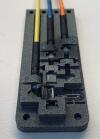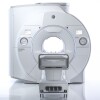Can diamond dust be a viable alternative to gadolinium for MR contrast?
by Gus Iversen, Editor in Chief | May 01, 2024
MRI

Researchers at the Max Planck Institute for Intelligent Systems
Researchers at the Max Planck Institute for Intelligent Systems in Stuttgart, Germany have made a gem of a discovery that they say could potentially transform medical imaging. In a recent experiment that originated with drug delivery research, nanometer-sized diamond particles showcased unexpected potential as an MR contrast agent, possibly offering a safer alternative to traditional gadolinium-based agents.
The experiment, led by research scientist Dr. Jelena Lazovic Zinnanti, revealed that diamond dust could enhance MR signals more effectively than gadolinium without the associated risks of leakage into surrounding tissues. The findings were published in the journal Advanced Materials, marking a significant milestone in the search for safer imaging technologies.
Gadolinium, though widely used, is known to migrate beyond targeted tissues, accumulating in the brain and kidneys, where it can remain for months or years, raising concerns about long-term health effects. The diamond dust, in contrast, showed promising retention within blood vessels without diffusing into surrounding areas during preliminary tests on live chicken embryos.

 The properties of diamond dust that enable it to function as a contrast agent remain a mystery. Dr. Lazovic Zinnanti speculates that the carbon in the nanoparticles might be slightly paramagnetic due to defects in their crystal lattice, mirroring some behaviors of gadolinium.
The properties of diamond dust that enable it to function as a contrast agent remain a mystery. Dr. Lazovic Zinnanti speculates that the carbon in the nanoparticles might be slightly paramagnetic due to defects in their crystal lattice, mirroring some behaviors of gadolinium.
However, further research is necessary to fully determine the safety and efficacy of diamond dust as an MR contrast agent. If proven safe, this carbon-based material could potentially replace gadolinium, reducing the risk of side effects and improving the precision of medical imaging.
This development opens up new possibilities for the use of nanotechnology in improving diagnostic procedures, with the potential to benefit millions of patients worldwide. The team at the Max Planck Institute, alongside collaborators, continues to explore the magnetic properties of diamond dust, aiming to unlock its full potential in medical applications.
This is not the first time unusual contrast agents have gained attention. In recent years, sugar, salt and barley have all shown promise.
Back to HCB News
The experiment, led by research scientist Dr. Jelena Lazovic Zinnanti, revealed that diamond dust could enhance MR signals more effectively than gadolinium without the associated risks of leakage into surrounding tissues. The findings were published in the journal Advanced Materials, marking a significant milestone in the search for safer imaging technologies.
Gadolinium, though widely used, is known to migrate beyond targeted tissues, accumulating in the brain and kidneys, where it can remain for months or years, raising concerns about long-term health effects. The diamond dust, in contrast, showed promising retention within blood vessels without diffusing into surrounding areas during preliminary tests on live chicken embryos.
We repair MRI Coils, RF amplifiers, Gradient Amplifiers and Injectors.
MIT labs, experts in Multi-Vendor component level repair of: MRI Coils, RF amplifiers, Gradient Amplifiers Contrast Media Injectors. System repairs, sub-assembly repairs, component level repairs, refurbish/calibrate. info@mitlabsusa.com/+1 (305) 470-8013

However, further research is necessary to fully determine the safety and efficacy of diamond dust as an MR contrast agent. If proven safe, this carbon-based material could potentially replace gadolinium, reducing the risk of side effects and improving the precision of medical imaging.
This development opens up new possibilities for the use of nanotechnology in improving diagnostic procedures, with the potential to benefit millions of patients worldwide. The team at the Max Planck Institute, alongside collaborators, continues to explore the magnetic properties of diamond dust, aiming to unlock its full potential in medical applications.
This is not the first time unusual contrast agents have gained attention. In recent years, sugar, salt and barley have all shown promise.
Back to HCB News
1(current)
You Must Be Logged In To Post A CommentRegisterRegistration is Free and Easy. Enjoy the benefits of The World's Leading New & Used Medical Equipment Marketplace. Register Now! |
|










